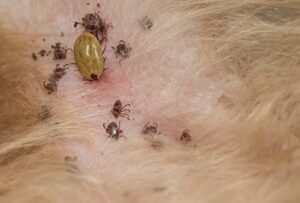Ticks are small, blood-sucking parasites that can be found in many areas around the world. They are commonly found in grassy or wooded areas and can attach themselves to animals (including dogs) as they pass. Ticks can transmit diseases to dogs, such as Lyme disease, ehrlichiosis, and Rocky Mountain spotted fever, which is why many dog enthusiasts care to know how to keep ticks off dogs.
Fortunately, there are steps that dog owners can take to prevent ticks from attaching to their pets. The practical methods are regular checking, tick and flea sprays, insecticide baths, medicated collars, and tick-preventative medications, which you can purchase. These medications are applied to the dog’s skin or taken orally and help to repel or kill ticks before they can attach.
Other preventive measures include:
- Regularly check your dog for ticks.
- Keeping your yard clear of tall grass and leaf litter.
- Avoiding areas where ticks are known to be present.
Taking these precautions can help keep your dog safe from ticks and the diseases they can transmit.
How to keep ticks off dogs
Dog owners can use several methods to prevent ticks from attaching to their pets. One option is to use tick and flea sprays, which are applied to the dog’s coat and help to repel ticks and other parasites.
Insecticide baths are another option, which involves bathing the dog in a solution that contains insecticides. Medicated collars are another option, which release small amounts of insecticides onto the dog’s coat over a while.
It is essential to carefully follow the instructions for any tick-prevention product and use it as directed. Some effects may be toxic to cats, so it is necessary to keep them away from cats and to use products specifically designed for dogs.
It is also a good idea to regularly check your dog for ticks and remove any found ones as soon as possible. To remove a tick:
- Grasp it as close to the skin as possible and gently pull it straight out.
- Avoid squeezing or crushing the tick, as this can cause its body to break and potentially release infectious fluids.
- After removing the tick, dispose of it by placing it in a sealed bag or jar or flushing it down the toilet.
By using a combination of these methods, you can help protect your dog from ticks and the diseases they can transmit.

What kills ticks on dogs naturally?
You can use several natural methods to kill ticks on dogs. One option is to use essential oils, such as peppermint or lemon. These oils can be diluted with a carrier oil (such as coconut oil) and applied to the dog’s coat.
Another option is to use herbs, such as rosemary or thyme, which can be steeped in hot water to create a natural tick repellent.
It is important to use caution when using natural tick prevention methods, as some essential oils and herbs can be toxic to dogs if used in high concentrations or ingested. It is always a good idea to consult with a veterinarian or a professional animal herbalist before using any natural remedies on your dog.
In addition to using natural methods, it is also essential to regularly check your dog for ticks and remove any found as soon as possible. By using a combination of natural remedies and regular tick checks, you can help protect your dog from ticks and the diseases they can transmit.
Does vinegar repel ticks on dogs?
Some evidence suggests that vinegar may be effective in repelling ticks on dogs. Vinegar contains acetic acid, which is believed to interfere with the ticks’ ability to locate a host by blocking their sense of smell. However, vinegar should not be used as the sole method of tick control for your dog.
It is pertinent to note that vinegar is not a registered tick repellent, and its effectiveness may vary. In addition, vinegar can irritate the skin and should not be applied directly to your dog’s coat. It is always best to consult with a veterinarian or use products designed explicitly for tick control on your dog.
What instantly kills ticks on dogs?
Several products can instantly kill ticks on dogs. One option is to use a tick-specific insecticide, such as permethrin or pyrethrin, which can be applied to the dog’s coat.
These products work by disrupting the tick’s nervous system, causing them to become paralyzed and eventually die. Another alternative is to use a tick-specific spot-on treatment, which is applied directly to the skin and works to kill ticks as they feed.
It is vital to carefully follow the instructions for any tick-prevention product and use it as directed. Some effects may be toxic to cats, so it is crucial to keep them away from cats and to use products specifically designed for dogs.
In addition to using tick-specific products, it is also essential to regularly check your dog for ticks and remove any found ones as soon as possible. By using a combination of tick prevention products and regular tick checks, you can help protect your dog from ticks and the diseases they can transmit.
What do ticks hate on dogs?

Ticks hate certain chemicals and substances and physical factors such as heat and movement. Some common repellents that may help keep ticks off dogs include essential oils, citronella and eucalyptus, and chemicals. One of them is permethrin, a synthetic compound toxic to ticks.
Furthermore, using a tick collar or spot-on treatment that contains these substances can help to repel ticks from dogs. It is essential to carefully follow the instructions for any tick control product, as improper use can harm both pets and humans.
In addition to using repellents and other chemical treatments, there are also physical methods that can help to prevent ticks from attaching to dogs.
These methods include regularly checking and grooming your dog to remove any ticks present and keeping your dog in a fenced yard or on a leash to prevent them from coming into contact with ticks in tall grass or other areas where ticks may be present.
Using a combination of chemical and physical methods, you can help protect your dog from ticks and the diseases they can transmit.
How to remove ticks from dogs
Ticks are tiny parasites that attach to the skin of dogs and other animals and can transmit diseases such as Lyme disease and Rocky Mountain spotted fever. To remove a tick from a dog, follow these steps:
1. Use fine-tipped tweezers or a tick removal tool to grasp the tick as close to the skin as possible.
2. Pull the tick straight out with steady, gentle pressure. Do not twist or jerk the tick, as this can cause the mouthparts to break off and remain in the skin.
3. After removing the tick, clean the bite area with rubbing alcohol or soap and water to help prevent infection.
It is essential to regularly check your dog for ticks and remove them promptly to reduce the risk of infection. You can also use tick-preventative products, such as collars or topical treatments, to help prevent ticks from attaching to your dog in the first place.
What removes ticks on dogs instantly?
Ticks can be removed from dogs instantly by using fine-tipped tweezers or a tick removal tool. To remove a tick, grip it as close to the skin as possible and pull it straight out with steady, even pressure. Do not twist or jerk the tick, as this can cause the mouthparts to break off and remain in the skin. After removing the tick, disinfect the bite area and wash your hands with soap and water.
Removing ticks from dogs as soon as possible is essential, as ticks can transmit Lyme disease, Rocky Mountain spotted fever and ehrlichiosis. To prevent ticks from attaching to your dog, use a tick-preventive product, such as a spot-on treatment, collar, or chewable tablet.
These products are available from your veterinarian or a pet supply store. It is also essential to regularly check your dog for ticks, especially after being outdoors or in areas with tall grass or other vegetation where ticks may be present.

What will draw a tick out of a dog?
You can use several methods to remove ticks from dogs. One approach is to use a tick removal tool, which is a small, pointed device that is specifically designed for removing ticks. To use a tick removal tool, you must grasp the tick as close to the skin as possible and gently pull it straight out.
It is essential to avoid squeezing or crushing the tick, as this can cause its body to rupture and release infected fluids into the dog’s skin.
Another method for removing ticks from dogs is to use a substance that will cause the tick to release its grip and fall off. Some people believe that applying a small amount of rubbing alcohol or baby oil to the tick’s body will cause it to release its grip and fall off. Use caution when using any substance to remove a tick, as some substances may be toxic to dogs if ingested.
In addition to using tick removal tools or substances, it is also essential to properly dispose of the tick after it has been removed. You can do this by placing the tick in a small container of rubbing alcohol, sealing it in a plastic bag, and disposing of it in the trash.
By adequately removing ticks and disposing of them, you can help protect your dog from ticks and the diseases they can transmit.
How do you permanently remove ticks from a dog?
To remove a tick from a dog, use tweezers or gloves to grasp it as close to the skin as possible and pull it straight out with steady, even pressure. Avoid squeezing the tick, as this can cause it to regurgitate its stomach contents into the dog’s skin, potentially transmitting disease.
Please dispose of the tick by placing it in a container with rubbing alcohol or flushing it down the toilet, and clean the bite area with rubbing alcohol or soap and water.
To prevent ticks from attaching to your dog, consider using a tick-preventative medication prescribed by your veterinarian, and check your dog for ticks regularly, especially after spending time in areas where ticks are common. If the bite area becomes infected, contact your veterinarian.
How to keep ticks off dogs home remedies
Several home remedies may help keep ticks off dogs, ranging from the use of essential oils, herbs, and others. Avoid getting the oils in your dog’s eyes, nose, or mouth.
Here are our 12 home remedies that may help keep ticks off dogs:
1. Garlic: Garlic is thought to have natural tick-repelling properties. You can add small amounts of garlic to your dog’s food or use a garlic-based tick repellent.
2 Apple cider vinegar: Apple cider vinegar is believed to repel ticks when applied to the skin. Mix equal parts water and vinegar and apply them to your dog’s coat using a spray bottle.
3. Cedar oil: This natural oil has been shown to repel ticks and other pests. You can apply it directly to your dog’s coat or add a few drops to their shampoo.
4. Lemon juice: Citrus oils like lemon juice can help repel ticks. You can mix a few tablespoons of lemon juice with water and apply it to your dog’s coat or add a few drops to their shampoo.
5. Apple cider vinegar: This natural product has antibacterial and antiparasitic properties and can help repel ticks. You can mix water and apple cider vinegar in equal parts and apply them to your dog’s coat or add a few tablespoons to their shampoo.
6. Rosemary: This herb has natural tick-repelling properties and can be used in a few different ways. You can mix a few drops of rosemary oil with water and apply it to your dog’s coat or add fresh or dried rosemary to their food.
7. Keep your dog’s fur trimmed: Ticks are more likely to attach to longer hair, so keeping your dog’s coat trimmed can make it harder for ticks to find a place to connect.
8. Use tick repellents: There are several natural tick repellents that you can use on your dogs, such as essential oils like citronella, lemongrass, and eucalyptus. These oils can be diluted in water and applied to your dog’s fur using a spray bottle.
9. Create a tick-free zone: Keep your lawn and outdoor areas well-maintained and free of tall grass and weeds, providing suitable habitat for ticks.
10. Use tick prevention products: There are several products available that can help prevent ticks from attaching to your dogs, such as tick collars and topical medications. These products should be used as directed by your veterinarian.
11. Check your dog regularly: Regularly checking for ticks is vital in preventing tick-borne diseases. Check all areas of your dog’s body, including the ears, paws, and between toes. If you find a tick, remove it immediately using a tick removal tool.
Does apple cider vinegar kill ticks on dogs?

Apple cider vinegar may help repel ticks when applied to the skin, but it is not effective in killing ticks on dogs. Ticks must be physically removed from the skin to be killed, and using a substance like apple cider vinegar to kill a tick on a dog’s skin may not be effective. It could cause irritation or discomfort for the dog.
To remove a tick from a dog, use tweezers or gloves to grasp it as close to the skin as possible and pull it straight out with steady, even pressure.
Avoid squeezing the tick, as this can cause it to regurgitate its stomach contents into the dog’s skin, potentially transmitting disease.
Furthermore, please dispose of the tick by placing it in a container with rubbing alcohol or flushing it down the toilet, and clean the bite area with rubbing alcohol or soap and water.
If you are concerned about ticks on your dog, you should speak with a veterinarian about the most appropriate prevention method for your pet. This may include using commercial tick prevention products or following a specific tick removal and prevention protocol.
Can ticks survive in vinegar?
Ticks can survive in vinegar for a short time, but they will eventually drown if submerged in vinegar. However, using vinegar as a tick control method is not recommended, as it is not an effective way to kill ticks.
To effectively kill ticks, they must be physically removed from the skin and then killed. Ticks can transmit diseases to humans and animals, so it is crucial to remove them as soon as possible.
Can Dettol kill ticks on dogs?
Dettol is a brand of disinfectant that is effective at killing bacteria and viruses, but it is not effective at killing ticks. Ticks must be physically removed from the skin to be killed, and using a substance like Dettol to try to kill a tick on a dog’s skin may not be effective and could cause irritation or discomfort.
If you are concerned about ticks on your dog, you should speak with a veterinarian about the most appropriate prevention method for your pet. Many effective tick prevention products, such as topical medications and collars, can provide long-lasting protection against ticks.
What disinfectant kills ticks?
Several disinfectants can kill ticks, including household products such as bleach, alcohol, and hydrogen peroxide. These disinfectants can kill ticks on hard surfaces, but they are not effective at killing ticks on the skin or in clothing.
If you find a tick on your skin, the best way to remove it is to use fine-tipped tweezers to grasp it as close to the skin as possible and gently pull it straight out. After removing the tick, you can disinfect the bite site with rubbing alcohol or another disinfectant.
It is essential to properly dispose of the tick by placing it in a sealed bag or container and disposing of it in the trash, as ticks can carry diseases that can be transmitted to humans.

Why is my dog still getting ticks after treatment?
There are a few possible reasons why your dog may still be getting ticks after treatment:
1. The tick prevention product may not be effective against the particular type of ticks your dog is encountering. Using a product specifically designed to prevent and control the type of ticks that are prevalent in your area is essential.
2. You may need to apply the tick prevention products correctly. Make sure you follow the package instructions and use the product as directed.
3. Your dog may be spending time in areas where ticks are prevalent, such as wooded or grassy areas. It is vital to keep your dog away from these areas as much as possible or to use additional preventive measures, such as a tick collar or tick spray, when your dog is in these areas.
4. Your dog may have an underlying health condition that makes them more susceptible to tick infestations. If you suspect this may be the case, it is essential to consult your veterinarian for further evaluation and treatment.
Conclusion

How to keep ticks off dogs can do this by using a tick prevention product that is appropriate for your pet and following the instructions for use. Regularly checking your dog for ticks and removing any ticks found as soon as possible can also help prevent tick infestations.
It’s also a good idea to avoid areas where ticks are prevalent, such as wooded or grassy areas, and to groom your dog regularly to remove any ticks that may be present.
Overall, using a reliable tick prevention product and taking additional precautions to protect your dog from tick infestations is essential.


